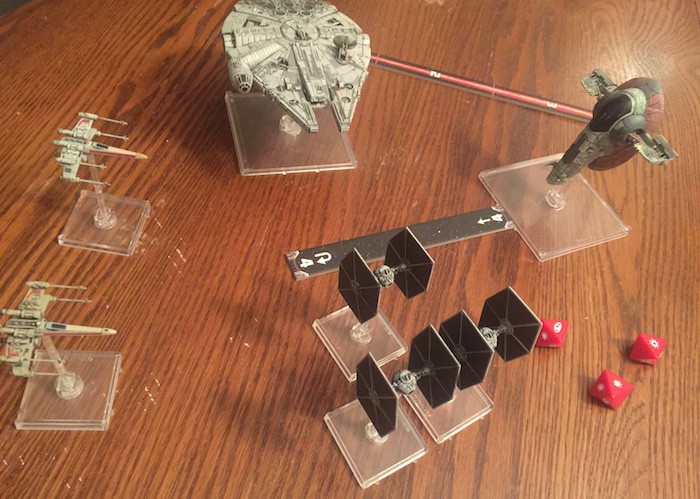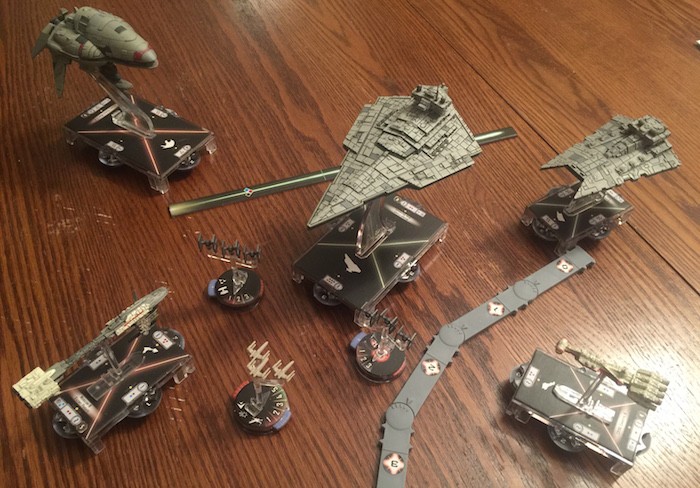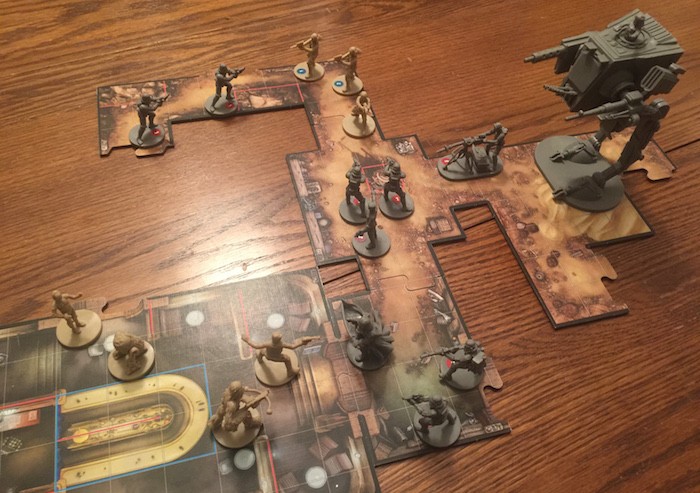'Star Wars' Board Games Every Fan Should Play, Episode I [Cardboard Cinema]
We are living in the golden age of board games.
Really! Whether you realize it or not, the days of Monopoly and Risk are far behind us. Sure, those games still exist, primarily lining the edge of the toy section at your local big box retailer, but there is no reason for you to ever play them again. The "classic" games of the past, the games that seem to inspire so much dread and eye-rolling from so many people, have been supplanted by smart, impeccably constructed, tabletop experiences. From simple party games to massive, complex epics, there is a designer board game for every taste.
There is one thing that unites every board game worth playing. The best games, the ones that stick with you, tell stories. Whether they're economic simulations themed around managing a medieval farm or tactical experiences that allow you to play general to an army on a battlefield, the great modern game crafts a narrative and throws you into it. You and your allies and opponents are the characters in a narrative. The game may take 30 minutes to play or it may take six hours, but you are participating in group storytelling. This is your tale to tell, and the spaceships and wooden tokens and plastic figures on the board are the elements of your tale of victory and defeat.
Welcome to Cardboard Cinema, a new feature where the lines between movies and board games blur. For the debut excursion into the dual world of film and tabletop fandom, let's dive into a subject that will inspire a familiarity and fondness in just about everyone. Let's talk about some Star Wars board games.
You know Star Wars. Originally released in 1977, George Lucas' beloved space opera shattered records and molded the minds of an entire generation. Over the course of six films, the series encountered its fair share of ups and downs, but its popularity never wavered. Even those burnt by the prequel trilogy of the late '90s through mid '00s are buying tickets to Star Wars: The Force Awakens two months in advance.
When tasked with recommending board games that will appeal to a Star Wars fan (i.e., just about everyone), there are two possible paths.
You could suggest some officially licensed games which plunge players straight into the world of Star Wars. There is a surprising wealth of good stuff in this approach – look past Star Wars Monopoly and other similar nonsense and you'll find some genuinely great experiences. Fantasy Flight Games, the modern king of glossy, thematic hobbyist board games, has been releasing top-notch, Disney and Lucasfilm-approved Star Wars games for some time now.
You could also suggest one of countless science fiction games that exist in their own unique setting but inspire feelings similar to that of Star Wars. There are games out there that will put you in control of your own spaceship, send you on epic adventures, and strap you into all kinds of emotional roller coasters (Your dad is Darth Vader! You just kissed your sister! It's a trap!).
So let's split the difference. Let's talk about a few official licensed Star Wars board games worthy of your time, money and attention as well as some games that will appeal to similar tastes. Each of these games couldn't be more different from one another, but each one of them throws you into a story and tasks you with clawing your way to desperate and dramatic victory. If you want to experience the breadth of the Star Wars universe and every feeling that those movies entail, these are the games for you.
Consider this a two-parter with a cliffhanger. Today, we'll talk about the officially licensed Star Wars games you need to play. In a few days, we'll return with the sequel, which will delve into other science fiction games worthy of your time and money.
X-Wing
The first and most popular game in Fantasy Flight Games' Star Wars library, the X-Wing miniature game is one of the company's most popular and exciting products for a reason. Sure, tabletop games simulating tactical dogfights between aircraft is nothing new, but few have been so accessible and easy on the eyes. Plus, there's the fact that you're maneuvering little X-Wings and TIE Fighters instead of planes, and that blows the imagination wide open.
The variables are many, but X-Wing is actually a very simple game. Players assemble their squadron of ships according to a pre-determined point total. Both ships and the cards that modify them cost points and you want to be as efficient as possible, squeezing every drop of potential out of what you have. The complex decisions begin early. Do you spend those points to field an X-Wing equipped with stronger torpedoes piloted by Luke Skywalker, or do you go ahead and field another ship altogether, but piloted by a rookie without any special abilities? This is a game that can be won or lost by what you bring into the fight. Planning is key and finding builds that work is immensely satisfying.
But this is the kind of game that is a blast even when your ass is being kicked. Once your squadron is on the table, you secretly select what you want them to do on a small dial. One by one, these dials are revealed and players move their ships with handy cardboard tokens that measure distance, accounting for turns and even 180 degree flips. Once you're in the thick of a battle, X-Wing becomes drama incarnate as you sweat out every decision and hold your breath as your opponent chucks their dice. You cheer when Darth Vader's TIE Advanced blows the Millennium Falcon (and Han Solo with it) to smithereens. You scream when that seemingly ineffective Imperial Academy pilot inexplicably dodges every laser blast shot his way. The skirmishes you recreate in X-Wing would account for only a few minutes or cinematic screen time, but they are slowed down to an unbearable and tense tempo. This is the kind of game that makes you sweat in your seat.
There is no assembly required, immediately removing the biggest hurdle keeping casual and hardcore gamers alike from playing miniatures games in the first place. While so many games of this kind require players to purchase the model kit, assemble it, paint it, realize it looks like garbage, give up for a few months, try again, and eventually learn to live with their sub-par work, everything that comes with X-Wing is pre-assembled and pre-painted and they're top-notch. Ships from both sides of the conflict look like they flew straight out of the movies – watching such detailed and lovingly recreated versions of your favorite spaceships duel one another on your table is a sight that never gets old.
If there's one big, huge flaw with X-Wing, it's that the starter box doesn't offer nearly enough content to properly enjoy the game for more than a session or two. However, this flaw is rendered null and void by the literally dozens of expansion packs that are available, allowing you to build out your fleet with ships from the Star Wars movies, the expanded universe, and even some crazy ships that were created exclusively for the game. X-Wing can be a money pit if you're not careful, but at least it's a money pit that gives you the appropriate amount of bang for every buck spent. Collecting every ship, from the tiny A-Wing to the massive, foot-long Tantive IV, is addictive.
Whether you're interested in the ongoing (and very popular) tournament scene or simply want to have a bunch of great models on hand to battle your friends, X-Wing has been one of the most consistent pleasures available to Star Wars fans in the realm of tabletop gaming. No other game has so perfectly captured the thrill of piloting a spaceship into battle. Every triumph and every failure carries the weight of the Star Wars universe.
Star Wars: Armada
While X-Wing simulates ferocious dogfights between a handful of small ships, Star Wars: Armada pulls the camera back to showcase a much larger canvas. Sure, Rebel X-Wings and Imperial TIE Fighters are present, but they are tiny blips, their models a non-scale representation of a large squadron. The real focus is the massive, unwieldy ships that command them. Let's put it this way: X-Wing lets you control, well, an X-Wing. Armada lets you control a Star Destroyer. Or two. Or three.
X-Wing's younger cousin may not have the same passionate fanbase (yet), but it features many of the surface similarities that made Fantasy Flight Games' first foray into the Star Wars universe such a success. The pre-assembled, pre-painted models of Armada are lovely to look at and there is a constant thrill to watching these ships trade fire on your table. The setup is also similar, with players building their fleets based on a set number of points. Is Grand Moff Tarkin really worth those 38 points when you could bring in quite a few more TIE Fighter squadrons for that cost? A smart load-out, and a strategy that takes advantage of what you've brought to the fight, can make the difference between victory and defeat.
But the similarities end there. Unlike the small, maneuverable ships of X-Wing, the juggernauts of Armada drive like boats. They can't turn on a dime. The cardboard movement tools have been replaced with a hugely satisfying plastic strip that clicks left and right, allowing you carefully plot your path... or to pilot your frigate right into an enemy ship. Once again, you issue your commands through hidden dials, but now the larger ships require you to utilize two or three dials, forcing you to think several turns ahead. The result is a game that plays less like Top Gun and more like Master and Commander: The Far Side of the World. Your ships are not the work of one man, they are the work of thousands. They cannot respond in an instant and have to approach every engagement with caution. If X-Wing is about fast engagement, hitting-and-running, and constantly searching for a new target, Armada is about making a few key decisions and dealing with the fallout.
There are few games in tabletop gaming that capture the dread of realizing that you've fallen for an enemy's gambit and that their starboard side, the home of their most powerful guns, is right alongside your unshielded stern. Because unlike X-Wing, the gigantic ships of Armada have different cannons on each of their four sides and each of those four sides has a shield, and you need to keep track of all of it. This additional micromanagement will frustrate some players, but thrill others (you know who you are). Screw up once and watch your vessel take the beating of a lifetime.
When the situation is reversed, though, you'll cheer alongside the imaginary crew inside your tiny, gigantic ship. We did it!
If I was forced to choose between the two, I'd take the suspenseful naval strategy of Armada over the high-speed Air Force tactics of X-Wing. Still, both games scratch such different itches and both are worth owning and playing. The barrier of entry is a little higher on Armada thanks to its price point (its base box costs more than double that of X-Wing), but the expansion costs are comparable. And for many Star Wars fans, it will be worth every cent. X-Wing skirmishes are exciting stuff, but only Armada captures the grandeur of Return of the Jedi's big space battle.
Star Wars: Imperial Assault
If X-Wing and Star Wars: Armada scratch different itches on the same limb, then Star Wars: Imperial Assault takes care of a tingle on an entirely separate limb. With this game, Fantasy Flight Games has recreated the ground-based action of the Star Wars saga, letting players control squads of Stormtroopers and teams of Rebel heroes as they clash across countless missions, exchanging blaster fire through the narrow corridors of Imperial bases and battling in the deserts of Tatooine. Yes, there is even a giant plastic AT-ST that dwarfs everything else in the box.
There are two games in Star Wars: Imperial Assault and both are exceptional. The first is a campaign mode and it actually slides right into the new canon, taking place directly after the events of Return of the Jedi. Most of the players take control of an individual Rebel soldier, part of a strike team sent to track down the Empire's remaining strongholds and stamp them out. Any items they collect and abilities they learn are kept from game to game, making Imperial Assault a role playing game at its core. Unlike most RPGs, there is one player trying his or her hardest to destroy these heroes. This player solely controls the forces of the Empire and commands wave after wave of Stormtroopers and Imperial officers, sending them after the Rebel scum. This one-versus-all dynamic makes the game work, as the players learn to hate and fear the mastermind behind the Imperial forces and the Empire player watches everyone else try avoid the traps he or she has laid for for them.
In fact, seasoned gamers may recognize this portion of the game as a heavily modified riff on FFG's own Descent series, which allowed players to embark on high fantasy adventures through dungeons and caverns full of monsters and mayhem. Having played both, I'm of the opinion that Imperial Assault is the better of two, taking the lessons learned from years of Descent development and fine-tuning them before transferring everything to the Star Wars setting.
As much fun as the campaign is, Imperial Assault really shines with its Skirmish mode, where it is essentially a ground forces version of X-Wing and Armada. Think of it as a massive sandbox of Star Wars goodness. One player is the Rebel forces, the other the Empire. They build their armies up to a point limit and construct a deck of special power cards. Then this cast of characters is unleashed upon a map, letting everyone blast the crap out of each other. The combat system is smooth and fair, with the beautiful components bringing the theme to life in visceral, hypnotic fashion. The attention to detail makes the insane match-ups that occur all the more amusing. Only in Imperial Assault will C3-PO and a wounded Rebel foot soldier find themselves attempting to defend a valuable passage against Darth Vader himself. Only in this game will Chewbacca get to exchange blaster fire with Boba Fett while Han Solo flees an army of Tusken Raiders.
Imperial Assault isn't quite as accessible as X-Wing or Armada, relying on a few too many symbols and a lot of card text. Learning the rules, especially if you're not a veteran of Descent or other "dungeon crawl"-style games, can be a chore. However, once you know the symbology, the game becomes easy enough. Learning its language and knowing what the many important keywords mean is a small price to pay for a game that lets you create and customize the insane Star Wars battles of your dreams.Join us in just a few days for part two of Cardboard Cinema's grand debut, where we'll dip our toe into the larger science fiction board game world.



